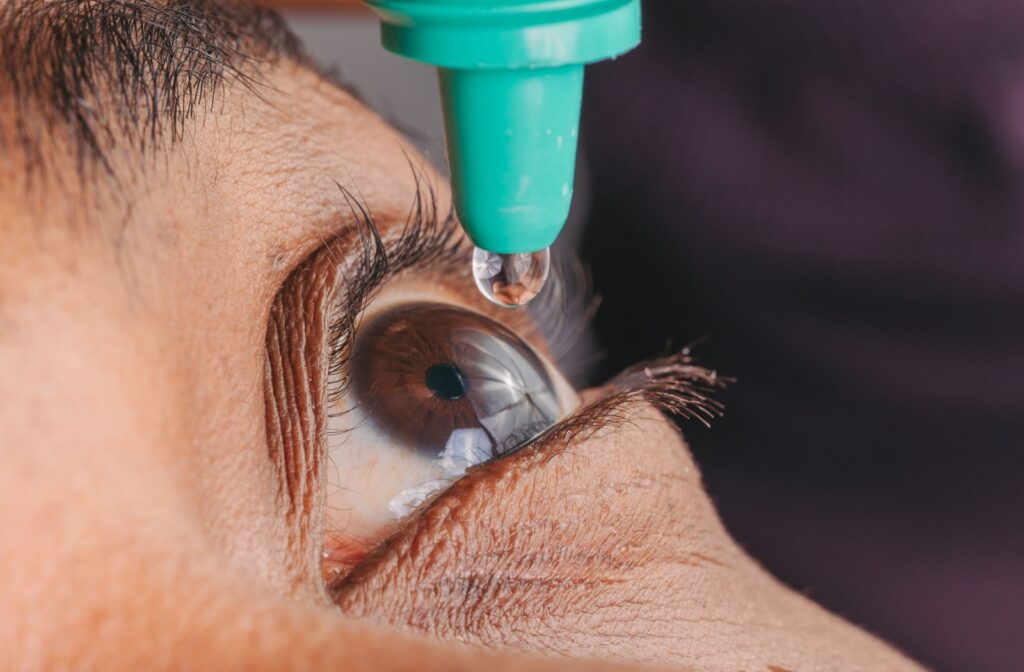Meibomian gland dysfunction (MGD) affects millions of people worldwide, causing uncomfortable symptoms that can significantly impact daily life. Meibomian gland dysfunction can last for a long time, as it’s often a chronic condition that requires lifelong maintenance.
Fortunately, there are effective treatments, like BlephEx or intense pulsed light (IPL) therapy, that can target MGD at its root and alleviate symptoms. Your eye doctor can examine your eyes and offer personalized advice on which treatment or combination of treatments could help with your symptoms.
Understanding Meibomian Gland Dysfunction
Meibomian glands are tiny, oil-producing glands located in your upper and lower eyelids. These glands produce meibum, an oily substance that forms the outer layer of your tear film. When these glands become blocked or don’t function properly, it leads to MGD.
MGD is the leading cause of dry eye disease. The condition creates a cascade of problems, like inadequate oil production, which ultimately leads to rapid tear evaporation and results in eye irritation, inflammation, and the uncomfortable symptoms associated with dry eye disease.
Common Symptoms of MGD
People with MGD typically experience:
- Dry, gritty sensation in the eyes
- Burning or stinging feelings
- Blurred vision that improves with blinking
- Eye fatigue, especially during screen time
- Sensitivity to light
- Excessive tearing
- Crusty eyelids, particularly in the morning
When Should You See Your Eye Doctor
If you suspect you have MGD, schedule an appointment with your eye doctor as soon as possible. Early evaluation is crucial for preventing the condition from worsening and for managing symptoms effectively.
You shouldn’t ignore symptoms like dry eyes, irritation, redness, blurry vision, or a gritty sensation in your eyes, as they may indicate MGD or other underlying eye conditions.
Factors that Influence MGD Duration
MGD exists on a spectrum. Mild cases may respond to treatment within weeks, while severe cases can take months or even years to resolve fully. The extent of gland blockage can impact recovery time. A couple of other factors that can determine how long until you see treatment results include:
- Underlying cause
- Age and overall health
- Treatment compliance
MGD Treatment Approaches
There are things you can try at home to alleviate MGD and dry eye disease symptoms, but the treatments your eye doctor can offer will typically offer longer-lasting and more effective results.

Over-the-Counter Treatment
- Warm compresses: Applying warm compresses for 10-15 minutes daily helps melt thickened meibum and improve gland function. Consistency is key—daily application shows better results than intermittent use. A warm compress mask typically provides the best results, as it keeps the heat on the eyelids where it’s needed.
- Eyelid hygiene: Gentle eyelid scrubs remove bacteria and debris that can worsen MGD. Use specialized eyelid cleansers or diluted baby shampoo applied with a clean cloth.
- Omega-3 supplements: High-quality omega-3 fatty acids may help improve meibomian gland function.
Medical or In-Office Treatments
- Prescription medications: Anti-inflammatory medications, including topical cyclosporine or lifitegrast, can help reduce inflammation and improve gland function. These medications often require 2-3 months of consistent use to show full effectiveness.
- BlephEx: This in-office treatment uses a gentle exfoliation technique to remove biofilm and debris from the eyelids, aiding in the management of MGD. It can improve symptoms, including dryness, redness, and irritation.
- Intense pulsed light (IPL): This treatment uses light energy to reduce inflammation and improve gland function. Most patients require 3-4 sessions spaced 2-3 weeks apart.
- Meibomian gland expression: Professional in-office expression can clear blocked glands and provide immediate relief. This procedure may need to be repeated periodically.
Preventing MGD Recurrence
There’s no way to prevent MGD, but you can lower your risk by implementing some good habits in your daily life:
- Screen time management: Follow the 20-20-20 rule—every 20 minutes, look at something 20 feet away for 20 seconds.
- Environmental control: Use humidifiers in dry environments and avoid sitting directly under or near air conditioning or heating vents.
- Nutritional support: Maintain a diet rich in omega-3 fatty acids, and consider taking supplements if your dietary intake is insufficient.
- Managing other health conditions: Blood pressure and blood cholesterol levels can affect conditions like MGD.
Ongoing Maintenance
MGD is often a chronic issue for many people. Even after successful treatment, MGD often requires ongoing maintenance to prevent recurrence:
- Continue daily warm compresses
- Maintain proper eyelid hygiene
- Regular follow-up appointments with your eye doctor
- Continued omega-3 supplementation
Living Successfully with MGD
Meibomian gland dysfunction doesn’t have to control your life. While the condition may be chronic for some people, effective treatments can provide significant relief and help you maintain comfortable, healthy eyes. With proper treatment and lifestyle modifications, most people with MGD can achieve substantial improvement in their symptoms and quality of life. Call our compassionate and dedicated team at West Valley Dry Eye today to book an appointment. We can examine your eyes and offer tailored advice on the most effective treatments available.


